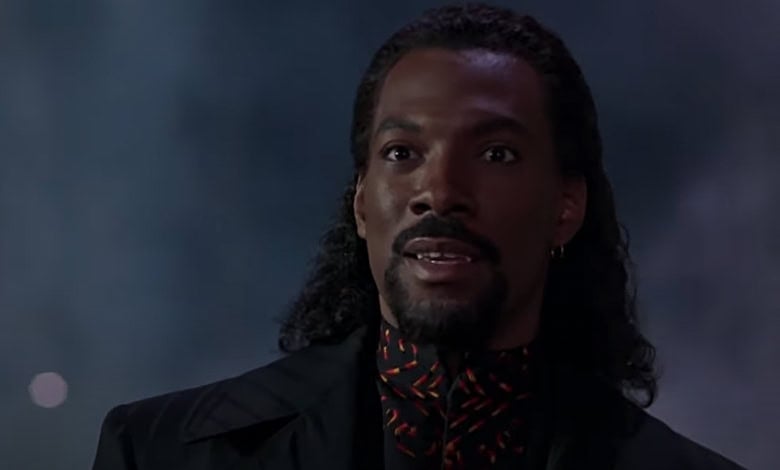
Wes Craven’s “Vampire in Brooklyn” (1995) is among the strangest curiosity items for cinephiles, a misfire upon release that has gained a genuine and affectionate cult following.
In pairing Craven, the undisputed master of horror, with Eddie Murphy, one of the biggest and best comic actors of his generation, Paramount Pictures gave genre fans one of the all-time strangest Halloween offerings.
There’s no resisting the curiosity of when a comedic actor collaborates with a serious director. Unlikely but potent, essential team-ups like Robin Williams and Peter Weir, Adam Sandler and Paul Thomas Anderson, Jim Carrey and Milos Forman, and Steve Martin and David Mamet come to mind.
The potentially tasty combo of Murphy and horror maverick Craven nearly undid the stature and reputation of both their careers, though the film itself is still an illogical, uneven but very entertaining curiosity item.
Murphy followed the disappointment of “Beverly Hills Cop III” (1994) and a number of movies that were watchable but not as strong as his ’80s vehicles, where he reigned as one of the biggest movie stars in the world.
Murphy can act, something that even casual viewers of his work would notice. His desire to stretch outside of his comfort zone, truly challenge himself and his fans (and, as he later admitted, get him out of his Paramount Pictures contract with one more movie) motivated him to try his hand at the horror genre.
Craven, meanwhile, was a movie away from his giant comeback as the director of “Scream” (1996) and, as his brilliant “Wes Craven’s New Nightmare” (1994) indicated, he was also disinterested in repeating himself.
Reports from the set and accounts by Craven and Murphy paint their collaboration as an enjoyable one, even as Murphy pushed for the horror angle and Craven wanted to make it more of a comedy.
The Franken-movie that resulted always seems like it could almost work as a hybrid, but never does.
Murphy plays Maximillian, an ancient vampire who arrives in New York by boat, searching for his bride. He turns Julius, a local hoodlum (Kadeem Hardison), into his “ghoul” servant, kills some local mobsters and stalks Rita, a detective (Angela Bassett), whom he chooses to be his bride.
Take away the police procedural and the set-up resembles a little of “Dracula” and a lot of Murphy’s “Coming to America,” with even his character’s accent suggesting that movie’s Akeem crossed with a Jamaican. Yet, while the one-liners come frequently, the look of the film is perfectly sinister.
The Murphy/Craven collaboration proves ambitious but should have settled on being a horror movie with light comedy, not a light comedy with obtrusive (though occasionally startling) touches of horror. There are one-liners that crackle and jolts of horror that work, undermined by ill-timed scares and some groan-worthy scenes.
The film wants to be “Blacula” (1972), “Candyman” (1992), “Michael Jackson’s Thriller” (1983) and “An American Werewolf in London” (1981), all in one. The problem is, Craven can’t balance shock and humor the way John Landis can.
Yet, this entertaining mess is much better and more consistently interesting than Murphy and Craven’s worst movies (Murphy’s 2007 “Norbit” and Craven’s 2010 “My Soul to Take”).
“Vampire in Brooklyn.” which was co-authored by Charlie Murphy, is full of little moments that work, which give the false promise that the film will get better, and the wobbly tone will stabilize. Instead, the fluctuation of genres frustrates.
The story is interesting, though Murphy’s narration oversells it. The powers Maximillian possesses are all over the map: suspension of disbelief is one thing, but consistency is another. Plus, composer J. Peter Robinson’s heavy-handed score lays it on too thick.
Everything is a mixed bag, including the performances. Murphy’s long-haired, wide-eyed, sharp-fanged monster is the real deal. He’s scary, charming and committed to this odd change of image.
Eddie Murphy in Vampire In Brooklyn(1995)
Directed by Wes Craven pic.twitter.com/dWfU7hx76H— None Of Them Knew (@KnewNone) January 2, 2022
Unfortunately, rather than allowing his performance to carry the movie, we get two additional characters. Since this worked in “Coming to America,” it doesn’t initially seem like an iffy choice. There are two scenes, back-to-back, with Murphy playing two characters who the vampire possesses: Maximillian/Murphy plays an Al Sharpton-like street preacher and a real goon of a mobster.
These scenes demonstrate Murphy’s skill at embodying a variety of roles and but also how he flails when the material is weak. “Preacher Paulie” and “Milo the Mobster” are not intolerable comic figures (though they’re arguably the most stereotypical here), but they distract from the intriguing, straight-faced leading turn Murphy is offering.
Bassett is so good and so beautiful; she’s a great match for Murphy, who has never had a truly strong actress to work with, ever, before or since. Even as the role gets outlandish in the third act, Bassett displays charisma, talent and presence to match Murphy’s.
She’s better than the material, of course, but their scenes together offer a glimpse of what the former Axel Foley could have had with a female co-star who could hold her own.
Hardison (who starred in the similar, better and nastier “Def by Temptation” in 1990) and professional scene stealer John Witherspoon play it very broad, courting outright stereotypical turns, but they’re constantly funny in a movie that doesn’t know what it wants to be.
